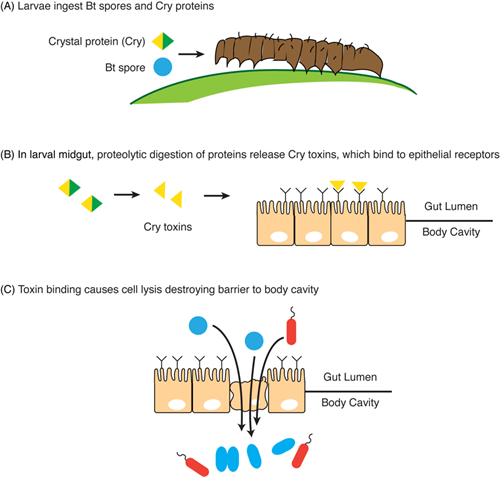PDF chapter test TRY NOW
Application of microbes:
Microorganisms contribute to human welfare in many ways. This section will learn about the various microbes applications in agriculture, where we can explore the different kinds of applications in great detail.
Microbes in agriculture:
Microbes play an essential role in agriculture as biocontrol agents and biofertilisers. Microbes play a vital role in cycling elements like carbon, nitrogen, oxygen, sulphur and phosphorus.
1. Microbes as biocontrol agents:
Biocontrol means the use of biological methods for controlling plant diseases and pests. Chemical pesticides and insecticides kill both harmful and beneficial organisms. They are toxic and extremely dangerous to both human beings and animals and pollute our environment (soil, groundwater), fruits, vegetables and crop plants. Biopesticides are used to combat this issue.
Microorganisms used to control harmful or pathogenic organisms and pests of plants are called biocontrol agents (Biopesticides).
Biopesticides are the biological agents which are used to control weeds, insects and disease-causing agents.
Bacillus thuringiensis (Bt) species bacteria lives in the soil; spores of this bacterium produce the insecticidal protein called ‘cry’ protein. In the gut of the hatchlings, the poisoning protein is discharged, and the hatchlings die. Therefore spores of this bacterium kill larvae of some insects.
Spores of B.thuringiensis are available in small sachets, dissolved in water and sprayed on plants infected with insect larva. Similarly, Trichoderma is a free-living fungus, and they are effective biocontrol agents against various plant pathogens.
Important!
The bacterium Bacillus thuringiensis (Bt) was the first biopesticide to be used on a commercial scale globally.

2. Microbes as biofertilizers:
“Biofertilisers are the elements that contain microorganisms, which when added to the soil increase its fertility and promotes plant growth”.
Overuse of chemical fertilisers is linked to pollution and harmful effects. The use of microorganisms as biofertilisers is highly recommended.
Biofertilisers are living organisms that improve the nutrient availability to crop plants either directly or through soil enrichment. They increase the availability of nutrients such as nitrogen and phosphorous. Some kinds of fungi and bacteria, such as cyanobacteria, are some of the important biofertilizers.
Nitrogen is one of the significant plant nutrient. Atmospheric nitrogen has to be converted to an available form of nitrogen. Nitrogen fixation is done by microbes either in free-living conditions or by having a symbiotic relationship with the plants. E.g. Nitrosomonas, Nostoc (free-living), symbiotic microbes like Rhizobium, Frankia, Mycorrhizae.
- Frankia is a non legume nitrogen-fixing actinobacterium that forms a symbiotic association with actinorhizal plants. It is a free-living filamentous bacterium found in root nodules or soil.
- Mycorrhiza indicates the relationship, which is a mutual symbiotic association between a fungus and a plant. It provides phosphorus present in the soil to the plant and makes it impervious to the root-borne pathogen. Mycorrhiza increase resistance to drought and salinity.
- Frankia is a non legume nitrogen-fixing actinobacterium that forms a symbiotic association with actinorhizal plants. It is a free-living filamentous bacterium found in root nodules or soil.
Reference:
http://sitn.hms.harvard.edu/flash/2015/insecticidal-plants/
